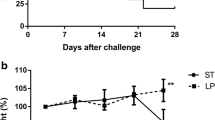Abstract
The present study was designed with the aim to study the modulation of giardiasis with natural intervention, i.e., Lactobacillus casei––a probiotic, in a murine model. Probiotics are viable microorganisms having a beneficial effect on the prevention and treatment of specific pathological conditions. Various dairy products such as curd, lassi, and kulfi were employed particularly to isolate live organisms (probiotics). Out of five isolated strains only one was found to be similar to a standard strain––Lactobacillus delbrueckii. Experimentally, it was observed that oral feeding of isolated strain A, 7 days prior to inoculation with Giardia lamblia trophozoites, was not as efficient as L. casei in eliminating Giardia infection from BALB/c mice. Interestingly, it was observed that L. casei fed 7 days prior to Giardia infection was more effective and efficient in eliminating the infection from mice. On histological examination, it was observed that probiotic-fed mice had less atrophied villi and infiltrating cells in the small intestine compared to the control. Ultrastructural studies by scanning electron microscopy further confirmed the protection of the mice dosed with L. casei 7 days prior to Giardia infection and also when simultaneously infected with Giardia. It is felt that probiotics, particularly L. casei, modulate Giardia infection by minimizing or preventing the adherence of Giardia trophozoites to the mucosal surface, suggesting that probiotics offer a safe and effective mode to prevent and treat Giardia infection.







Similar content being viewed by others
References
Craun GF (1996) Waterborne outbreaks of giardiasis : current status. In: SL Erlandsen EA Meyer (eds) Giardia and giardiasis : biology, pathogenesis and epidemiology. New York, Plenum, 243–261
Kramer MH, Herwaldt BL, Craun GF, Calderon RL, Juranek DD (1996) Surveillance for waterborne-disease outbreaks—United States, CDC surveillance summaries. Morb Mortal Week Rep 45(SS-1):1–30
Walia BN, Ganguly NK, Mahajan RC, Kimar D, Madan IJ, Gambhir SK, Kanwar SS (1986) Morbidity in preschool Giardia cyst excretors. Trop Geograp Med 38(4):367–370
Wolfe MS (1992) Giardiasis. Clin Microbiol Rev 5:93–100
Khanna R, Vinayak VK, Mehta FS, Kumkum RK, Nain CK (1988) Giardia lamblia infection in immunosuppressed animals causes severe alterations to brush border membrane enzymes. Dig Dis Sci 33:1147–1152
Eckmann L, Gillin FD (2001) Microbes and microbial toxins: paradigms for microbial-mucosal interactions I. Pathophysiological aspects of enteric infections with the lumen-dwelling protozoan Giardia lamblia. Am J Physiol Gastrointest Liver Physiol 280:G1–G6
Calzada F, Cerda GR, Meckes M, Cedillo RR, Bye R, Mata R (1999) Geranins A and B, new antiprotozoal A-typeproanthocyanidins from Geranium niveum. J Nat Prod 62:705–709
Gardner TB, Hill DR (2001) Treatment of Giardiasis. Clin Microbiol Rev 14:114–128
Upcroft P, Upcroft JA (2001) Drug targets and mechanisms of resistance in the anaerobic protozoa. Clin Microbiol Rev 14:150–164
Upcroft JA, Dunn LA, Wright JM, Benakli K, Upcroft P, Vanelle P (2006) 5-Nitroimidazole drug effective against Metronidazole-Resistant Trichomonas vaginalis and Giardia lamblia. Antimicrob Agent Chemother 50(1):344–347
Kandler O, Weiss N (1986) Regular, Non sporing Gram positive Rods. In Bergey’s manual of systemic bacteriology, Vol 2. Waverly, USA pp 1208–1233
Benyacoub J, Perez PF, Rochat F, Saudan KY, Reuteler G, Antille N, Humen M, De Antoni GL, Cavadani C, Blum S, Schiffrin EJ (2005) Enterococcus faecium SF68 enhances the immune response to Giardia intestinalis in mice. J Nutr 135:1171–1176
Vinayak VK, Sharma GL, Naik SR (1979) Experimental Giardia lamblia infectionin Swiss mice––a preliminary report. Indian J Med Res 70:195–198
Oyetayo VO, Adetuyi FC, Akinyosoye FA (2003) Safety and protective effect of Lactobacillus acidophilus and Lactobacillus casei used as probiotic agent in vivo. Afr J Biotechnol 2(11):448–452
Ney HC (1994) The crisis in antibiotic resistance. Science 257:1064–1073
Tannock GW, Munro HJ, Harmsen GW, Welling SJ, Gopal PK (2002) Analysis of the fecal microflora of human subjects consuming a probiotic product containing Lactobacillus rhamnosus DR 20. Appl Environ Microbiol 66:2578–2588
Lievin-Le MV, Amsellem R, Servin AL, Coconnier MH (2002) Lactobacillus acidophilus (strain LB) from the resident adult human gastrointestinal microflora exerts activity against brush border damage promoted by a diarrhoeagenic Escherichia coli in human enterocyte-like cells. Gut 50:803–811
Bibiloni R, Perez PF, De Antoni GL (1999) Will a high adhering capacity in a probiotic strain guarantee exclusion of pathogens from intestinal epithelia? Anaerobe 5:519–524
Haller D, Blum S, Bode C, Hammes WP, Schiffrin EJ (2000) Activation of human peripheral blood mononuclear cells by nonpathogenic bacteria in vitro: evidence of NK cells as primary targets. Infect Immun 68:752–759
Benyacoub J, Maulden GL, Cavadini C, Sauthier T, Anderson RE, Schiffrin EJ, Weid T (2003) Supplementation of food with Enterococcus faecium (SF68) stimulates immune functions in young dogs. J Nutr 133:1158–1162
Koji N (2005) Prevention of infection by Probiotics. J Biosci Bioeng 100(6):583–592
Humen MA, De Antoni GL, Benyacoub J, Costas MB, Cardozo MI, Kozubsky L, Saudan K, Doenzli-Bruand A, Blum S, Schiffrin EJ, Perez PF (2005) Lactobacillus johnsonii La1 antagonizes Giardia intestinalis in vivo. Infect Immun 73:1265–1269
Roberts-Thomson IC, Stevens DP, Mahmoud AA, Warren KS (1976) Giardiasis in the mouse: an animal model. Gastroenterol 71:57–61
Singer SM, Nash TE (2000) The role of normal flora in Giardia lamblia infections in mice. J Infect Dis 181:1510–1512
Author information
Authors and Affiliations
Corresponding author
Rights and permissions
About this article
Cite this article
Shukla, G., Devi, P. & Sehgal, R. Effect of Lactobacillus casei as a Probiotic on Modulation of Giardiasis. Dig Dis Sci 53, 2671–2679 (2008). https://doi.org/10.1007/s10620-007-0197-3
Received:
Accepted:
Published:
Issue Date:
DOI: https://doi.org/10.1007/s10620-007-0197-3




